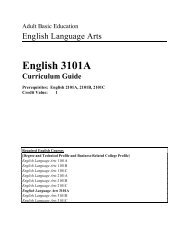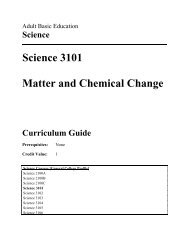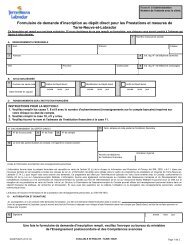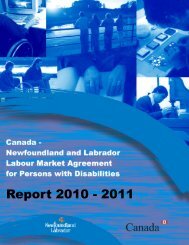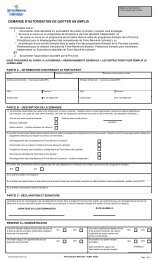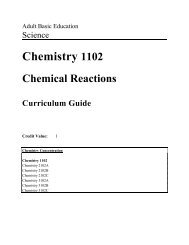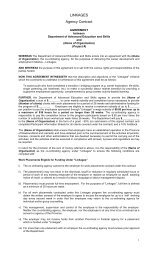Science Science 3102 Simple Machines and Energy Study Guide
Science Science 3102 Simple Machines and Energy Study Guide
Science Science 3102 Simple Machines and Energy Study Guide
- No tags were found...
Create successful ePaper yourself
Turn your PDF publications into a flip-book with our unique Google optimized e-Paper software.
Adult Basic Education<strong>Science</strong><strong>Science</strong> <strong>3102</strong><strong>Simple</strong> <strong>Machines</strong> <strong>and</strong> <strong>Energy</strong><strong>Study</strong> <strong>Guide</strong>Credit Value: 1Text: Nelson Physics 12: College Preparation; Hirsch, Alan J.; Nelson Thomson Canada;2004.<strong>Science</strong> Courses [General College Profile]<strong>Science</strong> 2100A<strong>Science</strong> 2100B<strong>Science</strong> 2100C<strong>Science</strong> 3101<strong>Science</strong> <strong>3102</strong><strong>Science</strong> 3103<strong>Science</strong> 3104<strong>Science</strong> 3105<strong>Science</strong> 3106
Table of ContentsTo the Student ............................................................... viIntroduction to <strong>Science</strong> <strong>3102</strong> .............................................. viUse of <strong>Study</strong> <strong>Guide</strong>s ................................................... viiRecommended Evaluation ............................................... viiiUnit 1 - <strong>Science</strong> Skills .................................................... Page 1Unit 2 - <strong>Simple</strong> <strong>Machines</strong> .................................................. Page 2Unit 3 - <strong>Energy</strong> .......................................................... Page 5Appendix A ............................................................. Page 9Appendix B ............................................................ Page 61
To the StudentI. Introduction to <strong>Science</strong> <strong>3102</strong><strong>Science</strong> <strong>3102</strong>, <strong>Simple</strong> <strong>Machines</strong> <strong>and</strong> <strong>Energy</strong>, is the first of two <strong>Science</strong> courses in the GeneralCollege Profile that covers concepts in the area of Physics. This course is a prerequisite to<strong>Science</strong> 3103, Electricity. While the course is available to all students, it is specifically designedfor those who plan to pursue post-secondary education in the area of industrial trades.In the first unit, <strong>Science</strong> Skills, you are introduced to the Workplace Hazardous MaterialsInformation System (WHMIS). You then cover some of the basic mathematical skills(specifically; use of the metric system, scientific notation, <strong>and</strong> significant digits) that are neededthroughout the remainder of this course <strong>and</strong> in <strong>Science</strong> 3103. The second unit, <strong>Simple</strong> <strong>Machines</strong>,introduces you to the various types of simple machines <strong>and</strong> explores how machines are useful inboth domestic <strong>and</strong> industrial settings. In unit three, <strong>Energy</strong>, you learn about the various forms ofenergy <strong>and</strong> how energy is changed, or transformed, from one form to another. You explorethermal energy in more detail <strong>and</strong> learn how it is related to heat <strong>and</strong> temperature.There are two labs (Core Labs ) <strong>and</strong> two assignments that students are required to complete forthis course. Your instructor may require you to complete additional lab activities <strong>and</strong>/orassignments.The textbook that you will need for the course is Nelson Physics 12: College Preparation;Hirsch, Alan J.; Nelson Thomson Canada; 2004.<strong>Study</strong> <strong>Guide</strong> v<strong>Science</strong> <strong>3102</strong>
To the StudentII.Use of <strong>Study</strong> <strong>Guide</strong>sBefore beginning this course, ensure you have the text <strong>and</strong> any other resources needed (see theinformation in the Introduction to this course for specifics).As you work through the <strong>Study</strong> <strong>Guide</strong>, you will see that it is divided according to the Units listedin the Table of Contents. When you open a unit it will have the following components:Reading for this Unit:Here you will find the chapters, sections <strong>and</strong> pages of the text you will use to cover the material for this unit. Skimthe sections of the textbook, look at the titles of the sections, scan the figures <strong>and</strong> read any material in the margins.Once you have this overview of the unit, you are ready to begin. Do not be intimidated by the content. You willwork through the text, section by section, gaining knowledge <strong>and</strong> underst<strong>and</strong>ing of the material as you go.References <strong>and</strong> NotesThis left h<strong>and</strong> column guides you through thematerial to read from the text. Read anyhighlighted notes that follow the readinginstructions. The symbols || direct you tothe questions that you should complete whenfinished a reading assignment..Work to SubmitYou come across three (3) headings in this right h<strong>and</strong> column.Writing:This section comprises your notes for the unit.Here you will find either written questions orreferences to specific questions or problemsfrom your text. You may want to write outeach question followed by the answer. Thismaterial should be checked by your instructorbefore moving on to the next unit.Mathematical problems should have theirsolutions checked as you go.Laboratory:Assignment:This section indicates if there is a Core Labthat should be completed for the unit. Let theinstructor know in advance that you will beready for the lab. A lab report should besubmitted for each Core Lab. Your instructorwill provide guidelines as to how s/he wantsthe report written.This section indicates if there is an assignmentthat should be completed for the Unit. Theinformation in the “References <strong>and</strong> Notes”column will indicate how you obtain theassignment. These assignments frequentlyrelate the science content to technology,society <strong>and</strong> the environment.<strong>Study</strong> <strong>Guide</strong> vi<strong>Science</strong> <strong>3102</strong>
To the StudentIII.Recommended EvaluationWritten Notes 10%Labs/Assignments 20%Test(s) 20%Final Exam (entire course) 50%100%<strong>Study</strong> <strong>Guide</strong> vii<strong>Science</strong> <strong>3102</strong>
Unit 1 - <strong>Science</strong> SkillsTo fulfill the objectives of this unit, students should complete the following:Reading for this unit:References <strong>and</strong> NotesNelson Physics 12: College PreparationAppendix A: Skills H<strong>and</strong>book: pages 546 - 548Appendix B: Safety Skills: pages 566 - 571Appendix C: Reference: page 572<strong>Study</strong> <strong>Guide</strong>Assignment 1 “Introduction to WHMIS”: Appendix AAssignment 2: “<strong>Science</strong> Skills”: Appendix BWork to SubmitAssignment 1 is found inAppendix A of this <strong>Study</strong> <strong>Guide</strong>.Read the material carefully <strong>and</strong>refer to pages 566 - 571 to helpyou do this assignment. ||Assignment 2 is found inAppendix A of this <strong>Study</strong> <strong>Guide</strong>.Refer to pages 546 - 548 <strong>and</strong> 572to help you do the assignment.||Assignment 1:1.1 Complete Assignment 1, “Introduction to WHMIS”.Assignment 2:1.2 Complete Assignment 2, “<strong>Science</strong> Skills”.Note: This unit is covered bycompletion of two assignments.You should pass both completedassignments in to your instructorfor marking. While you will notbe specifically tested on thematerial covered in theassignments, you will beexpected to apply this knowledgein all future work.<strong>Study</strong> <strong>Guide</strong> Page 1<strong>Science</strong> <strong>3102</strong>
Unit 2 - <strong>Simple</strong> <strong>Machines</strong>To fulfill the objectives of this unit, students should complete the followingReading for this unit: Nelson Physics 12: College PreparationChapter 2, Section 2.1, pages 70 - 76.References <strong>and</strong> Notes<strong>Study</strong> pages 70 - 76. Thenanswer questions 2.1 - 2.13 ||Note: You are studying onlysimple machines in this course.The other category of machinesis compound machines, whichare made up of two or moresimple machines workingtogether. Cars <strong>and</strong> dishwashersare examples of compoundmachines.Note: Ask your instructor for acopy of the worksheet, Classes ofLevers, to use when completing2.6 (c).Work to SubmitWriting:2.1 a) Define machine.b) List the five main functions of machines <strong>and</strong>give an example of a machine for each function.2.2 a) What are the two families of simple machines?b) List the ‘members’ of each family.2.3 Define lever <strong>and</strong> give a practical example of alever.2.4 What is a fulcrum?2.5 Define the following parts of a lever <strong>and</strong> give thesymbol for each:i) effort forceii) load forceiii) effort armiv) load arm2.6 a) Describe the three classes of levers.b) Give an example to illustrate each.c) Complete the worksheet, Classes of Levers.(See the Note opposite.)2.7 a) What is a biomechanical system?b) Give an example of a biomechanical system thatoperates as a simple machine <strong>and</strong> describe how itworks.<strong>Study</strong> <strong>Guide</strong> Page 2<strong>Science</strong> <strong>3102</strong>
Unit 2 - <strong>Simple</strong> <strong>Machines</strong>References <strong>and</strong> NotesWork to SubmitWriting:Note: Ask your instructor for acopy of the student worksheet,Identifying the Components ofLevers, to use for labelling thediagrams for question 2.9.Note: In the lab you will bemeasuring effort force (F E ) <strong>and</strong>load force (F L ). The unit used tomeasure force is the newton (N).You will also be asked tomultiply force by distance. Theunit for the product is thenewton meter (N.m).You should also note that allmeasurements for distance arerecorded in meters (m). If youhave taken your measurements incentimeters (cm), you will needto convert to meters.Refer to Investigation 2.2,Forces on Levers, page 78, to dothe laboratory. ||2.8 Describe the following types of simple machinesthat belong to the lever family <strong>and</strong> give an exampleof each:i) pulleyii) wheel <strong>and</strong> axleiii) gear2.9 Complete question 3 from the Practice on page 74.(See the Note opposite.)2.10 Describe the following types of simple machinesthat belong to the inclined plane family <strong>and</strong> givean example of each:i) inclined planeii) wedgeiii) screw2.11 What is a compound machine?2.12 Complete question 6 from the Practice on page 76.2.13 Complete question 1 from the Chapter 2.1Questions on page 77.Laboratory:2.14 Complete Investigation 2.2. (See the Noteopposite.) Pass your Lab Report in to yourinstructor for marking.<strong>Study</strong> <strong>Guide</strong> Page 3<strong>Science</strong> <strong>3102</strong>
Unit 2 - <strong>Simple</strong> <strong>Machines</strong>References <strong>and</strong> NotesWork to Submit<strong>Study</strong> pages 100 - 103. Thenanswer questions 2.15 - 2.16||Note: You likely use severalsimple <strong>and</strong>/or compoundmachines at home every day.These machines are referred toas domestic machines.Writing:2.15 Complete the Try This Activity, Domestic<strong>Machines</strong>, page 101.2.16 Give 2 examples of large compound machinesused in industries such as mining or construction<strong>and</strong> describe the function of each.Note: This is the end of Unit 2.See your instructor to find out ifthere is any other work that youneed to do for the unit or if youare required to do a test on theunit.<strong>Study</strong> <strong>Guide</strong> Page 4<strong>Science</strong> <strong>3102</strong>
Unit 3 - <strong>Energy</strong>To fulfill the objectives of this unit, students should complete the following:Reading for this unit:Nelson Physics 12: College PreparationChapter 3, Section 3.1, pages 128 - 131;Section 3.6, pages 149 - 152.References <strong>and</strong> NotesWork to Submit<strong>Study</strong> pages 128 - 131. Thenanswer questions 3.1 - 3.6 ||Writing:3.1 Define energy.3.2 List <strong>and</strong> briefly describe the various forms ofenergy.3.3 Complete Practice question 2 on page 129.3.4 a) What is energy transformation?b) What is meant by energy-transformationtechnology?3.5 Complete Practice question 3 on page 130.Note: Carefully study SampleProblem 1 on page 130 beforeyou do questions 3.5 - 3.6.3.6 Complete questions 1, 2, <strong>and</strong> 3 from Section 3.1Questions on page 131.<strong>Study</strong> <strong>Guide</strong> Page 5<strong>Science</strong> <strong>3102</strong>
Unit 3 - <strong>Energy</strong>References <strong>and</strong> Notes<strong>Study</strong> pages 149 - 151. Thenanswer questions 3.7 - 3.13 ||Work to SubmitWriting:3.7 a) What is thermal energy?b) On what three factors does thermal energydepend?3.8 Define heat.Note: Carefully study Figure 1(a) <strong>and</strong> (b) before you doquestion 3.10.3.9 Define temperature.3.10 Complete Practice questions 1 <strong>and</strong> 2 on page 150.3.11 What are the three methods of transferring heatfrom a warmer body to a cooler body?3.12 Describe each of the three methods of heat transfer<strong>and</strong> give an example of each.3.13 Complete Practice questions 4, 7, <strong>and</strong> 9 on page152.The lab activity, Effects of HeatTransfer, is found in Appendix Bof the <strong>Study</strong> <strong>Guide</strong>. ||Laboratory:3.14 Complete all parts of the lab activity, Effects ofHeat Transfer.Note: See your instructor to findout what is expected for yourLab Report. The lab reportshould be passed in to yourinstructor for marking.<strong>Study</strong> <strong>Guide</strong> Page 6<strong>Science</strong> <strong>3102</strong>
Unit 3 - <strong>Energy</strong>References <strong>and</strong> NotesWork to Submit<strong>Study</strong> page 152. Then answerquestions 3.17 - 3.18 ||Writing:3.15 What does the Law of Conservation of <strong>Energy</strong>state?3.16 What type of energy is often produced as “wasteenergy” in the operation of most machines?Note: This is the end of Unit 3.See your instructor to find out ifthere is any other work that youneed to do for the unit.<strong>Study</strong> <strong>Guide</strong> Page 7<strong>Science</strong> <strong>3102</strong>
Appendix A
Assignment 1Introduction to WHMIS
Instructions:Read the material carefully <strong>and</strong> answer the questions in the worksheets found at the end of eachsection. Pass in the worksheets ONLY to your instructor for marking.Section 1WHMIS: An IntroductionCase <strong>Study</strong>On his third day of a part-time job, a 19-year-old was pouring a drum of highly flammable chemicalinto small containers. Highly flammable means that the chemical can start a serious fire if noth<strong>and</strong>led properly. There were no warning labels on the drums that held the chemical. A sparkfrom static electricity made the chemical explode. The young worker suffered burns to 95% of hisbody. He died the next day.WHMIS (pronounced “wimis”) st<strong>and</strong>s for Workplace Hazardous Materials Information System.It is a Canada-wide information system set up to protect all Canadian workers <strong>and</strong> employers. Ahazardous material is any substance that can cause illness, disease or death to unprotectedpeople. Sometimes hazardous materials are called “hazardous products”, “controlled products”or “dangerous goods”.WHMIS provides vital information about any materials that pose a risk or hazard in theworkplace. This information is necessary to protect the health <strong>and</strong> safety of everyone in thework place.The WHMIS information system is based on a law in Canada that came into effect in October,1988. It states that everyone has a right to know about the hazardous substances that are beingused in their workplace. It requires suppliers, employers, <strong>and</strong> workers to use the system toidentify <strong>and</strong> h<strong>and</strong>le hazardous materials safely. WHMIS rules apply in every province <strong>and</strong>territory of Canada.People who do not follow the laws on hazardous materials can be charged with an offense <strong>and</strong>, ifconvicted, can be fined or jailed.Assignment 1Introduction to WHMIS
Why is it needed?In our daily lives there are hundreds of materials <strong>and</strong> chemicals which have been developed tomake our work easier <strong>and</strong> to allow us to make better products. In this process, there aresubstances that are used or produced that can be dangerous to people if h<strong>and</strong>led improperly.WHMIS lets us know which materials are dangerous, <strong>and</strong> how we can protect ourselves whenwe h<strong>and</strong>le them.The danger of hazardous materials can come from explosion, fire, skin contact, inhalation oringestion. How bad the danger is will usually depend on one or more of the following:• the amount of pressure there is (gases);• how easily the material burns or explodes;• the amount of material there is;• how toxic it is;• how it enters the body; <strong>and</strong>• its concentration.Who developed WHMIS?Once the need for a national information system was recognized, WHMIS was developed byjoint committees of employers, unions <strong>and</strong> governments.What problems does WHMIS try to solve?• unlabelled chemicals in workplaces;• lack of awareness by employers about the identity <strong>and</strong> hazards of the chemical they areusing;• inadequate information provided by suppliers to employers <strong>and</strong> workers, about thehazards of the chemical they are using; <strong>and</strong>• differences between provinces <strong>and</strong> territories in the way hazardous materials are h<strong>and</strong>led.The three main parts of WHMISWHMIS has three main parts to help identify <strong>and</strong> h<strong>and</strong>le hazardous materials safely:1. Labels: They are applied to the containers with materials inside. The labels supply vitalwarning information.2. Material Safety Data Sheets (MSDS): Sheets of information stored separately from thematerial. These sheets give details for h<strong>and</strong>ling emergencies, clean-ups, <strong>and</strong> controls forthe safe use of the hazardous materials. The law requires the employer to have a MSDSavailable for every hazardous material in the workplace.Assignment 1Introduction to WHMIS
3. Worker Education: Employers must provide instruction to each worker on how to useWHMIS, what hazardous materials are on site, <strong>and</strong> how to h<strong>and</strong>le them properly.Employee ResponsibilityWorkers have the responsibility to use the system to protect themselves from hazardousmaterials by:• recognizing labels;• checking the hazards; <strong>and</strong>• following recommended procedures.Employer <strong>and</strong> supplier responsibilities will be discussed in other activities.Exemptions of Products from WHMISSome products are already covered by other legislation. These have been partially exempt fromhaving to follow WHMIS requirements for labels <strong>and</strong> MSDS’s. Employers must still followWHMIS laws for these products by educating workers in the safe h<strong>and</strong>ling of the products <strong>and</strong>by using labels when the contents are transferred. These products include consumer products,cosmetics <strong>and</strong> drugs, explosives, pesticides ad radioactive substances.Some products are covered by other laws <strong>and</strong> are completely exempt from WHMIS. Theseinclude wood <strong>and</strong> products of wood, tobacco <strong>and</strong> products made of tobacco, hazardous wastes<strong>and</strong> manufactured articles.Assignment 1Introduction to WHMIS
Worksheet 1: WHMIS: An Introduction - QuizQuestions1. What should have been done on the work site to prevent the 19-year old worker fromlosing his life? (Refer to the Case <strong>Study</strong> at the beginning.)________________________________________________________________________________________________________________________________________________________________________________________________________________________________________________________________________________________________2. (a) WHMIS st<strong>and</strong>s for: __________________________________________________________________________________________________________________(b) What is WHMIS? __________________________________________________________________________________________________________________(c)What does WHMIS require suppliers, employers <strong>and</strong> workers to do?____________________________________________________________________________________________________________________________________3. Do WHMIS laws differ across Canada? ____________________________________________________________________________________________________________4. What is a hazardous material? __________________________________________________________________________________________________________________5. What are the three main parts of WHMIS? ____________________________________________________________________________________________________________Assignment 1Introduction to WHMIS
Worksheet 1 continued6. Hazards identified in the WHMIS system can come from: (Place a mark by those that areright.)a. _____ fire e. _____ inhalationb. _____ skin contact f. _____ ingestionc. _____ reading g. _____ seeingd. _____ explosion7. How bad a hazard is usually depends on one or more of the following: (Mark the answersthat you think are correct.)a. _____ the amount of material e. _____ how great the pressure isb. _____ the month of the year f. _____ how easily the materialburns or explodesc. _____ the manufacturer g. _____ how concentrated thematerial isd. _____ how toxic the material is h. _____ your elevationsAssignment 1Introduction to WHMIS
Section 2WHMIS: Responsibilities <strong>and</strong> LabelsResponsibilitiesThe responsibility for safely h<strong>and</strong>ling hazardous materials is shared by three parties:• the employer• the worker• the supplierThe Employer• The employer must tell you what hazardous materials you may come into contact with onthe site.• He/she must make sure that all hazardous materials on the job site are marked or labeledproperly in accordance with WHMIS rules.• Employers must have safe procedures for the use, h<strong>and</strong>ling, storage <strong>and</strong> disposal ofhazardous materials that are in use on the site. They must also have procedures forh<strong>and</strong>ling emergencies involving hazardous materials.• The employer is required to provide you, the worker, with training on:• how to use WHMIS labels <strong>and</strong> Material Safety Data Sheets. You must also be told whereMSDS’s are kept. Workers should have easy access to Material Safety Data Sheets eitherthrough the use of posters, computers or binders containing the sheets.• procedures for the safe use, storage, h<strong>and</strong>ling <strong>and</strong> disposal of the hazardous materials onthe work site.• procedures to follow in case of an emergency involving the hazardous materials.• the codes that are used <strong>and</strong> that are specific to the work site. Those codes may be colors,letters or numbers. As the codes may change from one work site to another, the employermust make sure that the employee is trained for his particular work site. Pipes, pumps, largecontainers, or vessels that carry hazardous materials should all be marked with these codes.• The employer is responsible for supplying <strong>and</strong> replacing all safety equipment related tohazardous materials <strong>and</strong> substances.Assignment 1Introduction to WHMIS
The WorkerYou have responsibility to:• receive information <strong>and</strong> be informed about hazardous materials on the work site;• learn how to use WHMIS;• follow recommended procedures to protect yourself <strong>and</strong> others; <strong>and</strong>• inform your employer of hazards <strong>and</strong>/or damaged <strong>and</strong> missing labels.The SupplierThe suppliers must provide labels <strong>and</strong> the information on the Material Safety Data Sheets. Theinformation on labels <strong>and</strong> MSDS’s are the foundation for the safe h<strong>and</strong>ling on hazardousmaterials.LabelsThe Workplace Hazardous Materials Information Systems has labels that are used to identifyhazardous materials. The purpose of the labels is to alert workers to main hazards of products<strong>and</strong> provide procedures for working with them, as well as to direct workers to the second part ofthe information system, the Material Safety Data Sheet.There are three main types of WHMIS labels:• Supplier Labels which are placed on the container by the manufacturer or distributor.The materials are then shipped to the workplace;• Workplace Labels which are placed on hazardous materials when needed on the job site.When any hazardous material is taken out of its supplier container <strong>and</strong> put into anothercontainer, workplace labels must be applied to the new container; <strong>and</strong>• Other means of identification in the workplace: pipes, tubes, pumps or vessels may beused to transport hazardous materials from one place to another. Since each work sitemay be different, the employer has to develop ways of warning the worker that there arehazardous materials present. Sometimes coloured flags or tapes are attached or thecontainers are coloured. As each employer has developed his/her own system forwarning employees, it is necessary that the employee be trained to recognize this “othermeans of identification” used by the employer.Assignment 1Introduction to WHMIS
Supplier LabelsWhen hazardous materials enter the workplace, the supplier label is the first warning sign thathazardous materials are present. The label may be placed on the container of hazardousmaterials by the supplier before shipping, or the supplier label may be included with theshipment <strong>and</strong> placed on the containers by the receiver when the shipment arrives at theworkplace. The supplier label has a special “hatch” border to draw attention to it. The label willsignal that hazardous materials are present.Suppliers must provide supplier labels on containers of products sold or imported into theworkplace.The supplier label provides these 7 types of information:product identifiersupplier identifierMSDS statementhazard symbolsrisk phraseprecautionary measuresfirst aid measuresthe name of the hazardous materialthe name <strong>and</strong> address of the suppliera statement indicating that a Material Safety Data Sheet for thatmaterial is available in the workplaceone or more of 8 WHMIS hazard symbols relevant to thehazardous materiala brief description of the hazard <strong>and</strong> the effects of exposure on thebodybrief instructions for the safe use of materialshow to treat persons who have been exposed to the material.Assignment 1Introduction to WHMIS
There is no specific rule for the size, shape or color of the label, but it must contrast with thebackground color of the container. In other words, a yellow label is not allowed on a yellowdrum or a blue label on a blue bottle, <strong>and</strong> so forth.A problem arises when the container with the hazardous material is small. It is difficult to fit alabel with all of the above information on a small bottle. When the container is less than 100milliliters, or one third of a can of pop, only the following information is required on the supplierlabel:• product identifier• supplier identifier• a statement making reference to a MSDS• hazard symbols showing the dangers associated with the materialSample Supplier LabelAssignment 1Introduction to WHMIS
Workplace LabelsThese labels must be placed on both hazardous materials produced in the workplace <strong>and</strong> onhazardous materials moved out of its original container into a new container. The workplacelabel is supplied by the employer <strong>and</strong> contains less information than the supplier label. It doesnot need to show a hazard symbol, <strong>and</strong> it is required to give only three of the seven kinds ofinformation:• product identifier - name of the products• precautionary measures - how to h<strong>and</strong>le it safely; <strong>and</strong>• a statement telling the reader that a Material Safety Data Sheet is available for thematerial.There are no specific requirements for the color, size or shape of the workplace label, <strong>and</strong> it hasno special border.Sample Workplace LabelToluene Sulphonic Acid 70%, LiquidWear protective gloves, apron, goggles <strong>and</strong> face shieldUSE IN WELL VENTILATED AREARefer to Material Safety Data SheetAssignment 1Introduction to WHMIS
Worksheet 2: WHMIS: Responsibilities <strong>and</strong> Labels - Quiz1. Who are the three main WHMIS participants?________________________________________________________________________________________________________________________________________________2. Mark the employer’s responsibilities with an “E” <strong>and</strong> the worker’s responsibilities with a“ME”._____ a)_____ b)_____ c)_____ d)_____ e)_____ f)_____ g)provide training on how to use WHMISlearn how to use WHMISprovide training on procedures for the safe use, storage <strong>and</strong> h<strong>and</strong>ling ofthe hazardous materials on sitelearn how <strong>and</strong> follow procedures for the safe use, storage <strong>and</strong> h<strong>and</strong>ling ofthe hazardous materials on siterecognize special color, number or letter codes on pumps, pipes <strong>and</strong>vessels carrying hazardous materialsdevelop emergency procedures <strong>and</strong> supply training to follow temclearly mark or label pumps, pipes <strong>and</strong> vessels carrying hazardousmaterials3. Write the letter of the employer’s responsibility in the blank that best matches the way inwhich employers can meet the requirement.Employer’s ResponsibilitiesWays employers can meet therequirements...a. Identify all hazardous materials on site check materials as they arrive fromsuppliersb. Make sure materials are labeled keep MSDS’s h<strong>and</strong>y on sitec. Provide information provide step-by-step training on the use,h<strong>and</strong>ling, storage or disposal ofhazardous materialsd. Develop procedures explain how to do things at a safety orstaff meetinge. Train workers place WHMIS posters on the job boardfor easy referenceshow <strong>and</strong> practice what to do in anemergencypost a list of all hazardous materials onthe siteAssignment 1Introduction to WHMIS
Section 3WHMIS: Product Classification <strong>and</strong> Hazard SymbolsOn the supplier label introduced in the last activity, there is a picture or symbol which shows thetype of hazard the material presents in the container. In total, there are eight different symbolsused to indicate type of hazard of the material in the container.These eight symbols are organized into 6 different classes of hazardous materials. The classesare lettered A through F. Class D, which is poisonous <strong>and</strong> infectious materials, has 3 divisionsfor different types of poisons. Each of these divisions has a symbol.• Class A - Compressed gas• Class B - Flammable <strong>and</strong> combustible material• Class C - Oxidizing material• Class D - Poisonous <strong>and</strong> infectious materialsDivision 1 - Materials causing immediate <strong>and</strong> serious toxic effectsDivision 2 - Materials causing other toxic effectsDivision 3 - Bio-hazardous infectious material• Class E - Corrosive material• Class F - Dangerous reactive material
Class A Class B Class C Class D Class E Class FClass B, flammable <strong>and</strong> combustible material, is also divided into subclasses or divisions.Unlike Class D, however, it does not have symbols for each of its divisions.Class B subclasses or divisions are:• Division 1 - flammable gas• Division 2 - flammable liquid (flash point below 37.82EC)• Division 3 - combustible liquid (flash point greater than 37.82EC)• Division 4 - flammable solid (can be ignited by heat or friction)• Division 5 - flammable aerosol (small drops of a liquid suspended in air)• Division 6 - reactive flammable material (flammable in air)Assignment 1Introduction to WHMIS
What is a flashpoint?When a liquid evaporates it gives off a vapor. The vapor combines with air to form a mixture. Ifenough vapor is present <strong>and</strong> mixed with air, the mixture can be ignited. A flashpoint is the lowertemperature at which a liquid gives off enough vapor to form a mixture that can produce a flame.Colour Coding <strong>and</strong> SymbolsSometimes the symbols are colour coded into three main groups: red for fire, blue for poison <strong>and</strong>yellow for “change”. Symbols in red would be Class B: flammable <strong>and</strong> combustible material;symbols in blue would be Classes D <strong>and</strong> E; symbols in yellow would be those belonging toClasses A, C <strong>and</strong> F.ExemptionsSome products such as pesticides, certain consumer products <strong>and</strong> explosives do not require thedistinctive WHMIS label because they are already covered by other labeling laws. WHMISrequires employers to provide training to workers. If those products are transferred to smallcontainers, WHMIS requires that workplace labels be applied.Assignment 1Introduction to WHMIS
Worksheet 3a: Match the WHMIS SymbolsMatch the symbol with the description on the right._____ Poisonous Materials_____ Compressed GasAB_____ Dangerously ReactiveMaterialsCD1_____ Flammable <strong>and</strong> CombustibleMaterials_____ Toxic MaterialsD2D3_____ Oxidizing Materials_____ Bio-Hazardous/InfectiousMaterialsEF_____ Corrosive MaterialsAssignment 1Introduction to WHMIS
Worksheet 3b: WHMIS Product Classification <strong>and</strong> Hazard Symbols - QuizExerciseComplete Part I of the WHMIS Quiz be checking off situations that apply to you. Thencomplete Part II of the quiz by using the classes <strong>and</strong> symbols information provided earlier.Part 1Instructions: Please a check before all questions you wouldanswer “yes” to.Part IIUsing your classes <strong>and</strong>symbols information,identify the appropriateWHMIS ClassWHMIS ClassG 1. Have you ever used rat poisoning? __________G 2. Have you ever used bleach? __________G 3. Have you ever used a propane barbecue? __________G 4. Have you ever used a Bunsen burner? __________G 5. Have you ever picked up an old battery? __________G 6. Have you ever filled your car up with gas? __________G 7. Have you ever painted with oil paints? __________G 8. Have you ever sat in your car while it was running? __________G 9. Have you ever touched raw chicken? __________G 10. Have you ever used nail polish remover? __________G 11. Have you ever changed a lantern mantle? ___________
Section 4WHMIS: Material Safety Data Sheets (MSDS)Material Safety Data Sheets (MSDS)The Material Safety Data Sheet is a very important technical document. There is a MSDS forevery hazardous material on site.Federal law requires that a supplier provide a MSDS for each controlled product. Newfoundl<strong>and</strong><strong>and</strong> Labrador law requires the employer to have a MSDS available for every hazardous materialin the workplace. The MSDS must be readily accessible to all workers, worker representatives<strong>and</strong> members of the occupational health committee.Every MSDS must be current (up to a maximum of 3 years is allowed between updates). TheMSDS must be revised within 90 days after new hazard information becomes known about thematerial.The MSDS has 9 main sections containing information which the employer should be aware of.None of these section should be left blank, but their order may vary.1. Product Identification <strong>and</strong> Use: the product name, identification number <strong>and</strong> use, aswell as information on how to contact the supplier <strong>and</strong> manufacturer.2. Hazardous Ingredient: the identify of the ingredients, their concentrations <strong>and</strong> estimatesof immediate <strong>and</strong> severe health effects.3. Physical Data: a physical description of the product.4. Fire <strong>and</strong> Explosion Data: information on the ability of the product to catch fire orexplode, <strong>and</strong> the means of extinguishing a fire.5. Reactivity Data: the ability of the product to react dangerously.6. Toxicological Properties: information on how materials enter the body <strong>and</strong> what theshort <strong>and</strong> long-term health effects are.7. Preventative Measures: information on control measures including ventilation, personalprotective equipment (gloves, respirators, etc.) <strong>and</strong> work procedures.8. First Aid Measures: information on immediate treatment in case of contact with theproduct.9. Preparation Information: information on who prepared the MSDS <strong>and</strong> when.Assignment 1Introduction to WHMIS
The MSDS contain more information than the required 9 sections. For example, some MSDS’swill include information about how to safely transport the product. This will be listed under“TDG” or “Transportation of Dangerous Goods”.ExemptionsSome companies do not want to disclose information on the MSDS because they would begiving away trade secrets. Some cleaners <strong>and</strong> soaps are examples of this. Those companiessubmit a request to a committee that approves or turns down the company’s request. Othersituations arise where consumer products fall under other laws; when this occurs, the MSDSdoes not have to have all parts completed.Assignment 1Introduction to WHMIS
Worksheet 4a: WHMIS Material Safety Data Sheets (MSDS’s)1. How many sections must be provided on a MSDS?______________________________2. What is the title of the section of the MSDS that tells who to contact if you havequestions about the products?________________________________________________________________________________________________________________________________________________3. Which section of the MSDS lists the special protective measures you can take to avoidharmful contact with the products?________________________________________________________________________________________________________________________________________________4. How often must a MSDS be updated?________________________________________________________________________________________________________________________________________________Assignment 1Introduction to WHMIS
Worksheet 4b: Using Material Safety Data SheetsThe following pages contain questions about a product you may be familiar with, WD40. Referto the MSDS sheet for the product to answer the following questions.WD401. What is the telephone number of the supplier? __________________________________Under what section of the MSDS did you find this information?________________________________________________________________________2. What problems can occur if you get WD40 in your eyes?________________________________________________________________________________________________________________________________________________Under what section of the MSDS did you find this information?________________________________________________________________________________________________________________________________________________3. What should you do if you get WD40 in your eyes?________________________________________________________________________________________________________________________________________________What could you have done to prevent it from happening?________________________________________________________________________________________________________________________________________________4. What engineering controls may be needed for this products?________________________________________________________________________________________________________________________________________________5. Are the ingredients of this product carcinogenic (cancer causing)?________________________________________________________________________________________________________________________________________________Assignment 1Introduction to WHMIS
* * * * * * * * * * * * * * * * * * * * * * * * * * * ** M S D S ** ** Canadian Centre for Occupational Health <strong>and</strong> Safety ** * * * * * * * * * * * Issue : 2000-1 (February, 2000) **** IDENTIFICATION ***MSDS RECORD NUMBER : 1671684PRODUCT NAME(S) : 3958-1020 WD40 FULL PALLET 3.785L & SPRAYPRODUCT IDENTIFICATION :MATERIAL SAFETY DATA SHEET : 00002589DATE OF MSDS : 1996-07-11CURRENCY NOTE :This MSDS was provided to CCOHS in electronic form on1998-04-27*** MANUFACTURER INFORMATION ***MANUFACTURER :K-G PACKAGINGADDRESS :8001 Keele StreetPost Office Box 89Concord OntarioCanada L4K 1B2EMERGENCY TELEPHONE NO.: 613-996-6666 (24 HRS) (CANUTEC)*** MATERIAL SAFETY DATA ***MATERIAL SAFETY DATA SHEET : 00002589---------------------------------------------------------------------------K-G PACKAGING8001 KEELE STREET P.O. BOX 89CONCORD, ONTARIO CANADA L4K 1B2CANUTEC EMERGENCY #:1-613-996-6666(24HR)---------------------------------------------------------------------------Product: 3958-1020 WD40 FULL PALLET 3.785L & SPRAY---------------------------------------------------------------------------SECTION 01: MANUFACTURER INFORMATION---------------------------------------------------------------------------MANUFACTURER........................K-G PACKAGING8001 KEELE STREET P.O. BOX 89CONCORD, ONTARIOCANADAL4K 1B2CANUTEC EMERGENCY #:1-613-996-6666(24HR)PRODUCT NAME...................... 3958-1020 WD40 FULL PALLET 3.785L & SPRAYCHEMICAL FAMILY................... ORGANIC MIXTURE.TRADE NAMES & SYNONYMS............ SAME AS PRODUCT NAME.PRODUCT USES...................... LUBRICANT/PENETRANT.CHEMICAL FORMULA.................. NOT APPLICABLE.MOLECULAR WEIGHT.................. NOT APPLICABLE.T.D.G. CLASSIFICATION............. NOT REGULATED.WHMIS CLASSIFICATION.............. B3.NFCC SECTION 4.1.................. CLASS II.NFPA CODE 30B..................... CLASS II.HMIS RATING FLAMMABILITY.......... 2 MODERATE HAZARD.HMIS RATING HEALTH................ 1 SLIGHT HAZARD.HMIS RATING REACTIVITY............ 0 MINIMAL HAZARD.Assignment 1Introduction to WHMIS
---------------------------------------------------------------------------SECTION 02: HAZARDOUS INGREDIENTS---------------------------------------------------------------------------% CAS / TLV LD/50, ROUTE, SPECIES LC/50, ROUTE,SPECIES---------------------------------------------------------------------------STODDARD SOLVENT10-30 8052-41-3 5g/kg 5g/m31OO ppm ORAL-RAT INHAL-RATPETROLEUM BASE OIL5-10 64742-65-0 NOT AVAILABLE NOT AVAILABLE5 mg/m3MINERAL SPIRITS60-100 64742-47-8 >5000 mg/kg 1400 ppm/4HNOT AVAILABLE ORAL - RAT INHAL - RAT---------------------------------------------------------------------------SECTION 03: PHYSICAL DATA---------------------------------------------------------------------------PHYSICAL STATE.................... LIQUID.BOILING POINT (DEG C)(CONC)....... >149.VAPOUR PRESSURE(PSIG)-AEROSOL..... NOT AVAILABLE.@ 20 CVAPOUR DENSITY (AIR=1)............ GREATER THAN 1.(BY WEIGHT)SOLUBILITY IN WATER............... NEGLIGIBLE.APPEARANCE........................ LIGHT AMBER.ODOR.............................. CHARACTERISTIC.ODOR THRESHOLD.................... NOT AVAILABLE.SPECIFIC GRAVITY (LIQUID)......... 0.78-0.82.PERCENT VOLATILE (BY WEIGHT)...... 72-75.EVAPORATION RATE.................. LESS THAN 1.n-BUTYL ACETATE = 1pH................................ NOT APPLICABLE.FREEZING POINT: (C)............... NOT AVAILABLE.COEFFICIENT OF WATER\OIL.......... NOT AVAILABLE.DIST.---------------------------------------------------------------------------SECTION 04: FIRE & EXPLOSION DATA---------------------------------------------------------------------------FLAMMABILITY...................... COMBUSTIBLE.IF YES, UNDER WHICH............... EXCESSIVE HEAT, SPARKS AND OPEN FLAME.CONDITIONS ?EXTINGUISHING MEDIA............... CARBON DIOXIDE, DRY CHEMICAL, FOAM.SPECIAL PROCEDURES................ WATER FROM FOGGING NOZZLES MAY BE USED TOCOOL CLOSED CONTAINERS TO PREVENT BUILD-UPIF EXPOSED TO EXTREME TEMPERATURES.FULLPROTECTIVE EQUIPMENT INCLUDING SELFCONTAINED BREATHING APPARTATUS SHOULD BEWORN IN A FIRE INVOLVING THIS MATERIAL.FLASH POINT(C),TAG CLOSED-CUP..... >42.(CONCENTRA TE)AUTO IGNITION TEMPERATURE (C)..... NOT AVAILABLE.LOWER FLAMMABLE LIMIT............. 1.(% BY VOLUME)UPPER FLAMMABLE LIMIT............. 6.(% BY VOLUME)HAZARDOUS COMBUSTIONPRODUCTS.......................... HYDROCARBON FUMES AND SMOKE. CARBONMONOXIDE WHERE COMBUSTION IS INCOMPLETE.EXPLOSION DATASENSITIVITY TO STATIC....... NOT APPLICABLE.DISCHARGESENSITIVITY TO IMPACT....... NOT APPLICABLE.---------------------------------------------------------------------------Assignment 1Introduction to WHMIS
SECTION 05: REACTIVITY DATA---------------------------------------------------------------------------CHEMICAL STABILITY:YES......................... UNDER NORMAL CONDITIONS.NO, WHICH CONDITIONS?....... NOT APPLICABLE.COMPATABILITY WITH OTHERSUBSTANCES :NO, WHICH ONES?............. STRONG OXIDIZING AGENTS.HAZARDOUS PRODUCTS OFDECOMPOSITION..................... HYDROCARBON FUMES AND SMOKE. CARBONMONOXIDE WHERE COMBUSTION IS INCOMPLETE.REACTIVITY CONDITIONS?............ NOT APPLICABLE.---------------------------------------------------------------------------SECTION 06: TOXICOLOGICAL PROPERTIES---------------------------------------------------------------------------ROUTE OF ENTRY:SKIN CONTACT................ MAY CAUSE IRRITATION.SKIN ABSORPTION............. NO DATA AVAILABLE FOR THIS PRODUCTMIXTURE.EYE CONTACT................. MAY CAUSE IRRITATION.INHALATION.................. INHALATION OF SOLVENTS MAY CAUSEIRRITATION.INHALATION, CHRONIC......... UNKNOWN.INGESTION................... MAY CAUSE HEADACHE, NAUSEA, VOMITING ANDWEAKNESS.EFFECTS OF ACUTE EXPOSURE......... DIZZINESS, NAUSEA. IRRITATION TO SKIN &EYES.EFFECTS OF CHRONIC EXPOSURE....... SOLVENTS MAY CAUSE DEFATTING DERMATITIS.EXPOSURE LIMIT OF MATERIAL........ SEE SECTION II.IRRITANCY OF MATERIAL............. SLIGHT.SENSITIZING CAPABILITY OF......... UNKNOWN.MATERIALCARCINOGENICITY OF MATERIAL....... THE INGREDIENTS OF THIS PRODUCT ARE NOTLISTED AS CARCINOGENS BY NTP, (NATIONALTOXICOLOGY PROGRAM), NOT REGULATED ASCARCINOGENS BY OSHA, (OCCUPATIONAL SAFETYAND HEALTH ADMINISTRATION), AND HAVE NOTBEEN EVALUATED BY IARC,(INTERNATIONALAGENCY FOR RESEARCH ON CANCER), NOR BYACGIH (AMERICAN CONFERENCE OF GOVERNMENTALINDUSTRIAL HYGIENISTS).REPRODUCTIVE EFFECTS.............. NO INFORMATION IS AVAILABLE AND NO ADVERSEREPRODUCTIVE EFFECTS ARE ANTICIPATED.TERATOGENICITY.................... NO INFORMATION IS AVAILABLE AND NO ADVERSETERATOGENIC EFFECTS ARE ANTICIPATED.MUTAGENICITY...................... NO INFORMATION IS AVAILABLE AND NO ADVERSEMUTAGENIC EFFECTS ARE ANTICIPATED.SYNERGISTIC MATERIALS............. NONE KNOWN.---------------------------------------------------------------------------SECTION 07: PREVENTIVE MEASURES---------------------------------------------------------------------------GLOVES/ TYPE..................WEAR CHEMICAL RESISTANT GLOVES.RESPIRATORY/TYPE..............IF USED INDOORS ON A CONTINUOUS BASIS, USEOF A CARTRIDGE TYPE RESPIRATORNIOSH/MSHATC 23C OR EQUIVALENT) ISRECOMMENDED.EYE/TYPE.................... SAFETY GLASSES.FOOTWEAR/TYPE............... RUBBER SAFETY BOOTS.OTHER/TYPE.................. NOT REQUIRED.ENGINEERING CONTROLS........ VENTILATION - LOCAL (MECHANICAL IF USED INDOORSON A CONTINUOUS BASIS).LEAK/SPILL................. REMOVE ALL SOURCES OF IGNITION. USE AN INERTABSORBENT MATERIAL, AND NON-SPARKING TOOLS.AVOID BREATHING FUMES. VENTILATE AREA. PREVENTAssignment 1Introduction to WHMIS
HANDLING PROCEDURES ANDEQUIPMENT..................FROM ENTERING A WATERCOURSE.STORE IN A COOL, WELL VENTILATED AREA NOT TOEXCEED 50 DEG C.WASTE DISPOSAL............. DO NOT PUNCTURE OR INCINERATE CONTAINERS, EVENWHEN EMPTY.DISPOSE OF IN ACCORDANCE WITH LOCAL,PROVINCIAL AND FEDERAL REGULATIONS.STORAGE NEEDS............... KEEP AWAY FROM HEAT, SPARKS, AND OPENFLAMES.---------------------------------------------------------------------------SECTION 08: FIRST AID MEASURES---------------------------------------------------------------------------EMERGENCY FIRST AIDPROCEDURE..................IN CASE OF EYE CONTACT, FLUSH IMMEDIATELY WITHPLENTY OF WATER FOR AT LEAST 15 MINUTES AND GETMEDICAL ATTENTION. FOR SKIN, WASH THOROUGHLYWITH SOAP AND WATER. IF AFFECTED BY INHALATIONOF VAPOUR OR SPRAY MIST, REMOVE TO FRESH AIR. IFSWALLOWED; DO NOT INDUCE VOMITING, GET MEDICALATTENTION.--------------------------------------------------------------------------SECTION 09: ADDITIONAL INFORMATION---------------------------------------------------------------------------NOTICE FROM CCL INDUSTRIESINC............................THE INFORMATION ON THIS MATERIAL SAFETYDATA SHEET IS PROVIDED BY CCL INDUSTRIESINC. FREE OF CHARGE. WHILE BELIEVED TO BERELIABLE, IT IS INTENDED FOR USE BYSKILLED PERSONS AT THEIR OWN RISK. CCLINDUSTRIES INC. ASSUMES NO RESPONSIBILITYFOR EVENTS RESULTING OR DAMAGES INCURREDFROM ITS USE. THE INFORMATION ON THISMATERIAL SAFETY DATA SHEET RELATES ONLY TOTHE SPECIFIC MATERIAL DESIGNATED HEREINAND DOES NOT RELATE TO USE IN COMBINATIONWITH ANY OTHER MATERIAL OR IN ANY PROCESS.DATED............................. 071196Assignment 1Introduction to WHMIS
ReminderMSDS’s must be readily available to all works at all times.Did you really underst<strong>and</strong> the MSDS?Here are some questions the worker should be able to answer.1. Can this product harm your health? Do you know the symptoms that may warn you ofover-exposure?2. Do you know the first aid measures needed in case of an over-exposure?3. Can this product burn or explode?4. Does your work site need any control measures such as special ventilation?5. Does this product require special h<strong>and</strong>ling precautions?6. Do you need any personal protective equipment?7. Do you need to be careful when mixing this product with other chemicals? Which ones?8. Does this product require any special storage conditions?9. Do you know what to do in case of a fire or explosion?10. Do you know what to do in case of a spill or leak?11. Do you know where the emergency response equipment is <strong>and</strong> how to use it?If the worker cannot answer any of these questions, he/she must talk to his/her employer,supervisor or safety officer before using the product.Assignment 1Introduction to WHMIS
Section 5WHMIS: Control of Hazardous MaterialsWhen hazardous materials are on the work site, it is necessary to control them, so the health <strong>and</strong>safety of the workers is protected.There are three routes that toxic substances may take to enter your body: inhalation, ingestion<strong>and</strong> absorption. Hazardous materials enter the body may have acute <strong>and</strong> chronic effects, or acombination of both effects.• acute effect: occur immediately or shortly after exposure; immediate death sometimesresults.• chronic effects: show up years later. The worker, by this time, may have had manyexposures. The period between the exposure to the hazardous material <strong>and</strong> the illness ofthe work is referred to as the latency period.Sometimes the body reacts strongly to defend against exposure. This is called sensitization.Examples of sensitization include rashes <strong>and</strong> asthma-like reactions such as wheezing <strong>and</strong>coughing. Sensitization is acquired over a period of exposures, but once sensitization occurs,low level exposure to the material will cause a strong reaction. Avoid exposure to the material isthe only solution to sensitization.A hazard control measure is something that is used to prevent workers from injury or frombecoming ill. A control measure may involve the way something is done or where it is done. Ifyou want to open a can, you can use a can opener, not a hammer. If you do not want to get painon furniture, you cover the furniture. These are examples of control measures.On the work site there are many different ways in which control measures are used. If a controlmeasure is to be of benefit, it must meet the following requirements:• It must adequately control the hazard. If the hazard is lethal there should be nocontact. The level of the hazard must be reduced, so there is no danger for the worker.• The control measure must create no new hazards. For example, the cover on thefurniture to protect it from paint should be arranged so no one can trip on it.• You must be able to do your job without unnecessary discomfort or stress.Protective clothing should fit properly. It should not be too big or too small.Assignment 1Introduction to WHMIS
• Every worker who comes into contact with the hazard must be protected by thecontrol measure. If a lab technician uses gloves, shouldn’t the nurse (who takes thesample) do so as well?• The hazard must be eliminated from the surrounding community as well as in theworkplace. If a substance is harmful, why remove it from the work site <strong>and</strong> release itinto the community?Types of ControlThere are three basic ways in which hazardous material can be controlled:• at the source: The hazardous material can be eliminated or substituted with a lesshazardous substance or material; for example, brake linings that do not contain asbestoscan replace those that do.• in the pathway: Barriers can be used to keep hazards away. For example, ventilationcan be used to remove fumes or to dilute the concentration of the hazardous substance bymixing it with fresh air. Chemicals that react when mixed can be stored far away fromeach other.• at the worker level: Personal protective equipment can be used <strong>and</strong> workers can beremoved or rotated from hazard areas to keep exposure to dangerous chemicals belowallowable limits.As a worker involved in health <strong>and</strong> safety, you should always be aware of the effects ofhazardous materials on you, your coworkers <strong>and</strong> the community. Your practices at work shouldprevent harm from coming to anyone. This involves knowing what is harmful. WHMIS is oneimportant tool used to recognize hazards present in the workplace <strong>and</strong> to learn how to deal withthem safely.Assignment 1Introduction to WHMIS
Worksheet 5: Control of Hazardous Materials1. What are the three ways chemicals can enter your body? ________________________________________________________________________________________________2. What are the two effects that hazardous materials may have on your body? Explain whateach type is. ____________________________________________________________________________________________________________________________________________________________________________________________________________________________________________________________________________________3. What is sensitization? ________________________________________________________________________________________________________________________________________________________________________________________________4. What is a control measure? ________________________________________________________________________________________________________________________________________________________________________________________________5. What are three methods by which a hazardous material can be controlled? ____________________________________________________________________________________________________________________________________________________________________________________________________________________________________________________________________________________________________________________________________________________________________________________________________________________________________________________________Assignment 1Introduction to WHMIS
Assignment 2<strong>Science</strong> Skills
Part I - Scientific NotationRewrite each number in scientific notation1. 50,000 ________________________2. 60,000,000 ____________________3. 0.000009 ______________________4. 0.0004 ________________________5. 461,000 _______________________6. 0.0000000004 __________________7. 0.0000000607 __________________8. 0.00000027 ____________________9. 51,200,000,000 _________________10. 150,000,000 ___________________11. 210,000,000,000 ________________12. 0.00009 _______________________13. 0.0000000000768 _______________14. 4,900,000,000,000 ______________15. 0.00000000605 _________________16. 1,080,000,000 __________________17. 0.000000000009 ________________18. 6,340,000 _____________________19. 0.0000000336 __________________20. 0.000037 ______________________21. 36,300,000,000 _________________22. 780,000,000 ___________________23. 0.00000062 ____________________24. 5,200,000 _____________________25. 36,600,000 ____________________26. 0.00000000578 _________________27. 5,000,000,000,000 ______________28. 0.000000000439 ________________29. 0.000802 ______________________30. 24,000 ________________________31. 646,000,000,000 ________________32. 0.00000679 ____________________33. 630,000 _______________________34. 7,000,000,000 __________________35. 0.00000000007 _________________36. 0.00000000000285 ______________37. 0.0000000077 __________________38. 46,000 ________________________Assignment 2<strong>Science</strong> Skills
Rewrite each number in decimal notation.1. 7 × 10 7 _______________________2. 5 × 10 -4 _______________________3. 8 × 10 -5 _______________________4. 2 × 10 6 _______________________5. 9.77 × 10 4 _____________________6. 2.1 × 10 -12 _____________________7. 8 × 10 8 _______________________8. 2.03 × 10 -9 ____________________9. 4.3 × 10 -7 _____________________10. 8.13 × 10 9 _____________________11. 2.6 × 10 -6 _____________________12. 8.4 × 10 12 _____________________13. 1.93 × 10 10 ____________________14. 9.48 × 10 5 _____________________15. 8.27 × 10 -8 ____________________16. 2 × 10 -10 ______________________17. 4.33 × 10 11 ____________________18. 9.52 × 10 -11 ____________________19. 5.23 × 10 -6 ____________________20. 6.1 × 10 -11 _____________________21. 1.38 × 10 6 _____________________22. 1.3 × 10 9 ______________________23. 5.73 × 10 -5 ____________________24. 5 × 10 11 _______________________25. 7.53 × 10 -4 ____________________26. 2.8 × 10 12 _____________________27. 1.1 × 10 -8 _____________________28. 7 × 10 4 _______________________29. 8.34 × 10 -10 ____________________30. 9.94 × 10 7 _____________________31. 6.12 × 10 -12 ____________________32. 1.1 × 10 5 _____________________33. 7.82 × 10 -7 ____________________34. 7.1 × 10 10 _____________________35. 4 × 10 4 _______________________36. 5.6 × 10 -9 _____________________Assignment 2<strong>Science</strong> Skills
Part II - Significant DigitsDetermine the number of significant digits in each of the following:1. 3427 _________________________2. 0.00456 _______________________3. 123,453 _______________________4. 172 __________________________5. 0.000984 ______________________6. 0.502 _________________________7. 3100.0 × 10 2 ___________________8. 0.0114 × 10 4 ___________________9. 107.2 _________________________10. 0.0000455 _____________________11. 2205.2 ________________________12. 30.0 × 10 -2 ____________________13. 0.982 × 10 -3 ___________________14. 0.0473 ________________________15. 650.502 _______________________16. 3.03 × 10 -1 ____________________17. 20.4 × 10 5 _____________________18. 1.29 __________________________19. 0.00565 _______________________20. 1362205.2 _____________________21. 450.0 × 10 3 ____________________22. 1000 × 10 -3 ___________________Round each of the following to 3 significant digits.1. 77.0653 _______________________2. 6,300,178.2 ____________________3. 0.00023350 ____________________4. 10.2030 _______________________5. 2.895 × 10 21 ___________________6. 707.5 _________________________7. 2,300.2 _______________________8. 0.0003350 _____________________9. 10.26730 ______________________10. 18.95 × 10 21 ___________________Assignment 2<strong>Science</strong> Skills
Part III - CalculationsCalculate the following. Give the answer in correct scientific notation <strong>and</strong> correctsignificant digits.1. (4.53 × 10 5 ) + (2.2 × 10 6 )5. (9.10 × 10 3 ) + 2.2 × 10 6 )2. 1913.0 - (4.6 × 10 3 )6. 1113.0 - (14.6 × 10 2 )3. (2.34 × 10 24 ) + (1.92 × 10 23 )7. (6.18 × 10 -45 ) + (4.72 × 10 -44 )4. (2.130 × 10 3 ) - (6.6 × 10 2 )8. (4.25 × 10 -3) - (1.6 × 10 -2 )Assignment 2<strong>Science</strong> Skills
Calculate the following. Give the answer in correct scientific notation <strong>and</strong> correctsignificant digits.1. 3.95 × 10 2 /1.5 × 10 65. 1.05 × 10 -26 /4.2 × 10 562. (3.5 × 10 2 )(6.45 × 10 10 )6. (2.5 × 10 9 )(6.45 × 10 4 )3. 4.44 × 10 7 /2.25 × 10 57. 6.022 × 10 23 /3.011 × 10 -564. (4.50 × 10 -12 )(3.67 × 10 -12 )8. (6.88 × 10 2 )(3.45 × 10 -10 )Assignment 2<strong>Science</strong> Skills
Part IV - Metric System1. What is the metric unit for linear measurement? ___________________2. What is the metric unit for volume measurement? _________________3. What is the metric unit for mass measurement? ___________________4. Explain the difference between mass <strong>and</strong> weight.________________________________________________________________________________________________________________________________________________5. Convert between metric units as indicated:a. 1.25 mm = _________________ cmb. 4.56 cm = _________________ mmc. 75.96 m = _________________ mmd. 0.0026 km = ________________mme. 0.0012 km = _________________mf. 7.25 m = ___________________cmg. 98.26 mg = __________________ gh. 0.082 cm = __________________ mi. 21.76 dL = _________________ daLn. 0.06 km = __________________ cmo. 4330 dg = __________________ hgp. 75 dam = __________________ hmq. 0.76 dL = ________________ daLr. 1.3 × 10 3 g = _______________ dags. 6.5 mm = __________________ μmt. 3.0 Mg = __________________ kgu. 3250 μm = ________________ cmv. 5.4 × 10 6 L = ______________ MLj. 43.7 hL = __________________ dLk. 2.0155 daL = ________________ hLl. 6.44 kg = ___________________ dgm. 2.087 hg = __________________ kgAssignment 2<strong>Science</strong> Skills
Appendix B
Core Lab # 2Effects of Heat TransferIntroduction:Heat can be transferred by conduction, convection <strong>and</strong> radiation. When matter is heated theparticles gain thermal energy. Particles with greater thermal energy move faster, <strong>and</strong> when theycollide, they move farther apart. This causes the material being heated to exp<strong>and</strong>. Conversely,when matter is cooled, it loses thermal energy. Particles with less thermal energy move slower,collide less frequently, <strong>and</strong> move closer together. This causes the material being cooled tocontract.If the matter gaining thermal energy is a solid, the particles do not have the ability to movearound. When the particles with increased thermal energy collide <strong>and</strong> move farther apart, thesolid will undergo linear expansion.If the matter gaining thermal energy is a fluid ( a gas or a liquid), the particles have the ability tomove around. When the particles with increased thermal energy collide <strong>and</strong> move farther apart,the fluid becomes less dense ( lighter) <strong>and</strong> the particles rise. They are replaced by coolerparticles from a neighbouring region of greater density. The continuous cycling of particlesestablishes convection currents.Assignment 3Effects of Heat Transfer
Part I t IMaterials• bimetallic strip• bunsen burner (or other heat source)ProcedureFollow strict safety procedures whenever an open flame is used.1. Light the bunsen burner <strong>and</strong> hold the tip of the bimetallic strip in the flame. Observe whathappens to the metals2. Before it cools, hold the bimetallic strip under cold water. Observe what happens.Analysisa) Describe what happens to the bimetallic strip in step 1. Explain what happened by applyingthe concept of conduction <strong>and</strong> expansion.b) Describe what happens to the bimetallic strip in step 2. Explain what happened by applyingthe concept of conduction.Assignment 3Effects of Heat Transfer
Part IIMaterials• convection box• touch paper (or paper towel)• radiometer• heat lamp• c<strong>and</strong>leProcedureFollow strict safety procedures whenever an open flame is used.Steps 1 - 2 should be carried out in a fume hood.1. Light the c<strong>and</strong>le under one of the chimneys in the convection box.2. Place the lit touch paper, or rolled up paper towel, over the other chimney. Observe whathappens to the smoke.3. Place the radiometer in strong sunlight or under a heat lamp. Observe what happens.Analysisa) Describe what happens to the smoke in Step. Explain what happened by applying theconcept of convection.b) Describe what happens in the radiometer in Step 3. Explain what happened by applying theconcepts of radiation <strong>and</strong> convection.Assignment 3Effects of Heat Transfer
Part IIIMaterials• 2 Erlenmeyer flasks (125ml or 250ml), or 2 jars of equal size <strong>and</strong> shape• hot <strong>and</strong> cold tap water• plastic tub or tray• red food colouring• small piece of heavy paper (or plastic)Procedure1. Place the flasks in a waterproof container (plastic tub or container), or in a sink. Fill theflasks to overflowing, one flask with cold water <strong>and</strong> the other with hot water. Add severaldrops of red food colouring to the hot water.2. Place the heavy paper on top of the flask of hot water <strong>and</strong>, holding the paper in place,carefully invert the flask.3. Carefully place the flask of hot water on top of the flask of cold water so that their rimsmatch exactly.4. Carefully remove the piece of paper from between the two flasks <strong>and</strong> observe any mixing.5. Repeat steps 2 - 4 with the flask containing the hot water on the bottom. Observe any mixing.Analysisa) Describe the mixing that occurred when the hot water flask was on top of the cold waterflask. Explain what happened.b) Describe the mixing that occurred when the cold water flask was on top of the hot waterflask. Explain what happened.c) Account for the difference between observations a) <strong>and</strong> b).Assignment 3Effects of Heat Transfer




